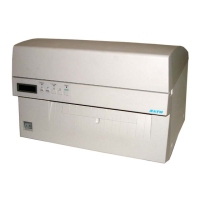PN 9001098
Rev. A
3-7
SATO M-10e TT/DT Printers Service Manual
Section 3. Interface Specifications
Ready/Busy Flow Control
Ready/Busy is the hardware flow control for the serial interface on the M-10e printer. By raising/
lowering the voltage level on Pin 20 of the RS232 port, the printer notifies the host when it is
ready to receive data. Pin 4 (RTS) and pin 20 (DTR) are the important signals on the printer for
this method of flow control. The host must be capable of supporting this flow control method for
it to function properly.
X-On/X-Off Flow Control
X-On/X-Off flow control must be used whenever hardware (Ready/Busy) flow control is not
available or desireable. Instead of a voltage going high/low at pin 20, control characters
representing “Printer Ready” (X-On = 11 hexadecimal) or “Printer Busy” (X-Off = 13
hexadecimal) are transmitted by the printer on pin 2 (Transmit Data) to the host. In order for this
method of flow control to function correctly, the host must be capable of supporting it. X-On/X-
Off operates in a manner similar to the function of pin 20 (DTR) as previously explained. When
the printer is first powered on it sends an X-Off when the “Buffer Near Full” level is reached and
a X-On when the data level of the buffer drops below the “Buffer Available” mark. When the
printer is taken off-line manually, it transmits an X-Off indicating it cannot accept data. When it is
placed back on line manually, it sends an X-On, indicating it is again available for receipt of data.
If an error occurs during printing (paper out, ribbon out), the printer sends an X-Off as soon as an
error condition is detected. When the error is cleared and the printer placed back on-line, it
transmits an X-On indicating it is again ready to accept data. Upon power up, if no error
conditions are present, the printer will continually send X-On characters at five millisecond
internals until it receives a transmission from the host.
Data Streams
The data streams for X-On/X-Off and Ready/Busy flow control are constructed in the same way
as they are for Ready/Busy flow control.
<ESC>A..Job #1..<ESC>Z<ESC>A..Job #n..<ESC>Z
Example: <ESC>A..Job#1..<ESC>Z
NOTE: All characters are in ASCII
3.6 Universal Serial Bus (USB) Interface
The Universal Serial Bus (USB) interface is a Plug-In Interface Module that can be installed by
the user. It requires a driver (shipped with each printer that has the interface installed) that must be
loaded on your PC and the PC must be configured to support USB peripherals using Windows 98
or above. Details for loading the USB driver are contained in the USB Interface Manual that is
shipped with each printer with a USB Optional interface installed. Up to 127 devices may be
connected to a USB port.
General Specifications
Connector: USB Type B Plug
Cable: 10 ft (3 m) max.
Host: Windows 98 or above with USB Port

